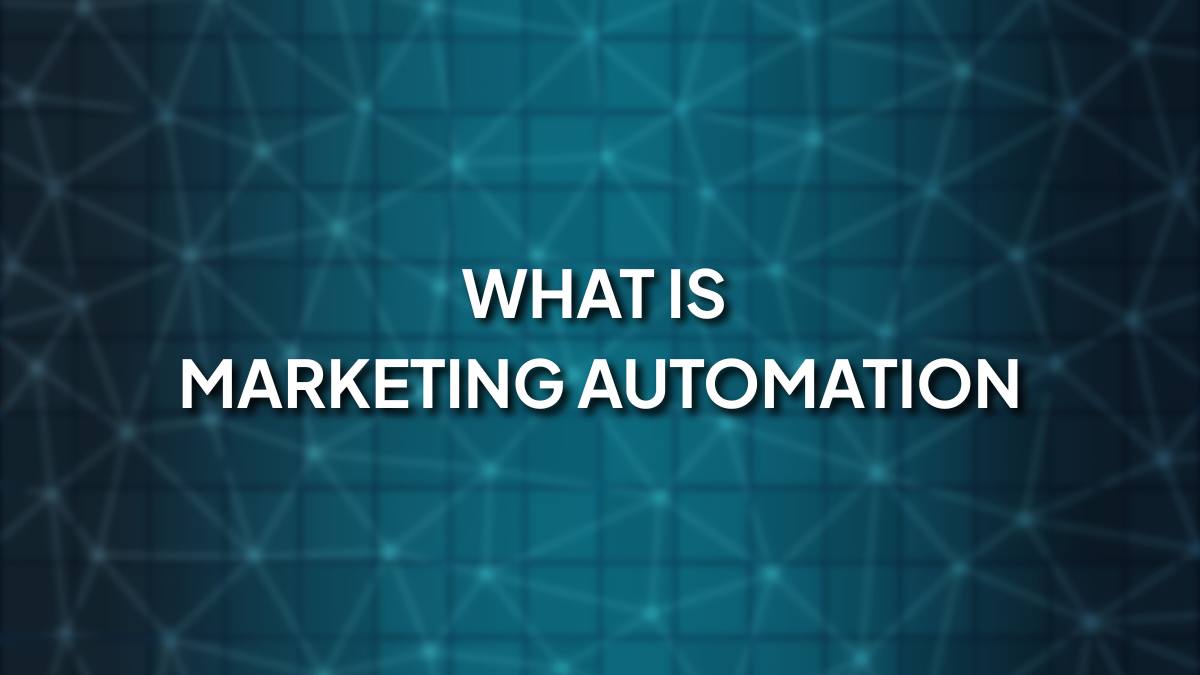If you’ve been around digital marketing even a little, you’ve probably heard the term “marketing automation” thrown around. It sounds a bit fancy, maybe even technical, right? Especially if you’re just starting out.
But honestly, it’s not as complicated as it sounds. It’s basically using software to handle repetitive marketing tasks for you, like sending follow-up emails or reminding people about their abandoned shopping carts, automatically. No more chasing leads one by one.
And these days, automation isn’t optional. People expect quick, personal replies, whether it’s on email, social, your website, or even WhatsApp.
In this guide, we’ll break down exactly what is marketing automation, how it works behind the scenes, which tools actually help, and how real businesses use it to grow faster. You don’t need to be a tech genius to get started, I’ll show you how. Let’s dive in.
Table of Contents
What is Marketing Automation?
Alright, let’s cut through the fluff here.
Marketing automation is using software to send the right message to the right person at the right time, automatically.
Imagine you have a little marketing assistant who works 24/7, doesn’t take coffee breaks, and remembers everything about your customers. That’s what marketing automation tools do for you.
But it’s not just emails anymore. Marketing automation can help you:
- Send SMS reminders
- Show specific ads to specific people
- Pop up a chatbot on your site when someone visits a certain page
- Score leads based on how likely they are to buy
- Even notify your sales team when someone’s “hot” and ready to convert
A quick history lesson:
Marketing automation started pretty small. In the early 2000s, it was mostly just about email drip sequences, like sending a welcome series after someone signed up for your newsletter.
But today? It’s full-stack. Meaning, automation connects your emails, your CRM, your website, your ads, your customer support… basically your whole digital ecosystem can be talking to each other on autopilot.
Key Tools & Platforms for Marketing Automation
Now, you don’t need to build this stuff from scratch. There are some awesome platforms out there that handle this for you:
- HubSpot – All-in-one automation, great for both small businesses and enterprises.
- ActiveCampaign – Amazing for email sequences, lead scoring, CRM integration.
- Mailchimp – Beginner-friendly if you’re starting out with email.
- Zapier – Connects all your different apps together, automates tasks between them.
- Make (formerly Integromat) – For more complex, visual automation workflows.
- Klaviyo – E-commerce automation wizard, integrates tightly with Shopify.
Which one is best? Honestly, depends on your business size and goals. But don’t worry, we’ll talk more about choosing the right tools later on.
How Does Marketing Automation Work?
Think of marketing automation like setting up a domino chain. You arrange all the pieces, and when someone takes an action (like clicking a button or downloading a PDF), the first domino tips over, and the whole sequence flows smoothly from there.
Let’s break it down.
1. Triggers
A trigger is the action that starts the automation. Example:
- Someone subscribes to your email list.
- Someone adds a product to their cart but doesn’t checkout.
- Someone clicks on a link in one of your emails.
2. Actions
Once the trigger happens, the automation tool starts performing actions. Example:
- Send a welcome email.
- Add them to a specific email sequence.
- Show them a retargeting ad on Facebook.
- Notify your sales team via Slack.
3. Workflows
A workflow is basically the whole map of triggers and actions stitched together. It’s the path that your leads or customers will follow automatically, depending on what they do.
Here’s a super-simple scenario:
Let’s say you’re offering a free ebook on your website.
- Visitor downloads the ebook: Trigger
- System sends them a thank-you email with the download link: Action
- 2 days later → another email with more helpful tips: Action
- 3 days later → personalized offer or invitation to book a call: Action
All happening while you’re asleep or sipping your third coffee of the day.
Behind the Scenes, The Real Magic
Good marketing automation usually connects:
- CRM (Customer Relationship Management) systems to track leads and customers.
- Email Marketing tools to communicate.
- Website Tracking (cookies, pixels) to know what users are doing.
- Ad Platforms to retarget and engage.
- Sometimes even SMS or WhatsApp for instant notifications.
This whole dance makes your marketing smarter, not spammy.
Also Read: Marketing Automation Strategy
Key Benefits of Marketing Automation for Your Business
If you’re wondering whether marketing automation is just another shiny marketing buzzword, here’s the honest answer: it’s not. It’s one of those things that, when done right, actually makes your life easier. And I don’t say that lightly.
Let’s break down the real benefits, no hype, just facts:
1. It Saves You a Ton of Time
No one wants to spend hours manually following up with leads or copying and pasting emails. Once you set up your workflows, they just run. While you sleep. While you’re at the gym. Even while you’re binging Netflix.
It’s like hiring an invisible assistant who never calls in sick.
2. Your Leads Don’t Go Cold
How many potential customers have you lost because you forgot to follow up? Marketing automation fixes that.
Let’s say someone downloaded your free checklist last week. Automation ensures they get timely follow-ups, not months later when they’ve forgotten who you are.
It keeps the conversation going, gently moving them closer to buying from you.
3. More Conversions Without More Effort
People don’t always buy on Day 1. But with the right email sequence or retargeting ad, they might say “yes” on Day 7, or Day 14.
Automation makes sure you’re showing up with the right offer, at the right time, without nagging or spammy tactics.
4. Personalization That Feels Human
Ever received an email that seemed like it was written just for you? That’s automation at work.
It lets you segment your audience by interests, actions, or demographics, so the dog lovers don’t get emails about cat food, and first-time visitors don’t get hit with “VIP customer” offers on Day 1.
5. Consistent Brand Experience Everywhere
We’ve all had that weird experience where a brand sends friendly emails, but their social ads feel aggressive, or their chatbot is downright rude.
With automation, everything can work together, emails, ads, website popups, SMS, you name it, to create one smooth, unified experience.
6. Smarter Decisions with Better Data
Here’s the real kicker: good marketing automation gives you data. You’ll know exactly how many people opened that email, clicked that link, or bailed on your webinar halfway through.
No more guessing. Just real numbers to help you make better moves next time.

Enroll Now: Advanced Generative AI for Marketing Course
Types of Marketing Automation You Should Know
Marketing automation isn’t just one tool; it’s more like a whole toolbox full of useful gadgets. Here are some of the main types you’ll want to know about:
1. Email Marketing Automation
This is usually the first step for most businesses. Think welcome sequences, abandoned cart emails, special offers, and newsletters that send themselves.
Example: Someone signs up → they get a 5-email welcome series → you introduce them to your products → they buy → they get a thank-you sequence.
2. Lead Scoring & Segmentation
Not all leads are created equal. Some are “just curious,” while others are basically waving their credit cards at you.
With automation, you can assign scores based on actions (like visiting pricing pages), helping you know who’s hot and who needs more nurturing.
3. Social Media Automation
Scheduling posts ahead of time is nice, but automation goes deeper. Imagine automatically DMing new followers with a welcome message or syncing Facebook Lead Ads with your CRM.
It keeps your social presence active, even when you’re offline.
4. CRM Integration & Automation
Think of your CRM like your customer notebook, but smarter. It’s where you keep track of who’s interested, who downloaded what, who’s hot, who’s not.
Automation makes sure that when someone does something, like grabs your free ebook, their profile updates in your CRM automatically. No spreadsheets. No sticky notes. No forgetting people.
And honestly? Sales teams love it. They don’t have to guess who’s worth calling. They know.
Also Read: What is Customer Relationship Marketing
5. Retargeting Ads Automation
Ever checked out a product, didn’t buy, and then suddenly that product is everywhere you go online? That’s retargeting. Creepy? Maybe. Effective? Definitely.
Automation connects what happens on your site to ads on Facebook, Google, Instagram, wherever. It’s not about being annoying. It’s about reminding people you exist when they’re already halfway interested.
6. AI-Powered Chatbots & Support
AI-Powered Chatbots are like having someone at the front desk all day and night. They don’t sleep. They don’t need breaks. They’re just there, answering the basic stuff like:
- “Where’s my order?”
- “How much does this cost?”
- “Can I return this?”
And if things get tricky, they can pass people off to a real person. But for the usual day-to-day stuff? Chatbots handle it.
7. Workflow Automation (Optional, but cool)
This is where things start feeling like magic.
Let’s say someone books a call with you. Automation can:
- Add them to your CRM
- Fire off a confirmation email
- Ping your sales team on Slack
- Start sending that lead helpful follow-up emails before you even speak to them. This kind of seamless experience is made possible through workflow automation, which connects your tools and tasks to run smoothly without manual input.
It’s like having invisible hands doing boring tasks for you so you can focus on the good stuff.
How Marketing Automation Enhances Customer Experience
Nobody wants to feel like just another email address in your list. People can tell when you’re just blasting emails hoping someone clicks.
Automation lets you talk to people at the right time with the right stuff. Feels better for them. Works better for you.
1. Timely, Relevant Content
Example: Someone checks your pricing page → gets an email the next day answering FAQs. Feels like you’re reading their mind. That’s good marketing.
Left something in their cart? A little nudge later might be all they need to finish the checkout.
2. Faster Responses
Waiting three days for a reply is over. Automation sends stuff instantly, like confirmations, receipts, or answers to easy questions, so people don’t have to sit there wondering what’s next.
3. Consistency Across Channels
It’s weird when you get friendly emails, but then ads from that same brand are aggressive or off. Automation helps everything feel connected. Like one person talking to you, not five people who don’t talk to each other.
4. Building Relationships, Not Just Sales
No one likes being sold to all the time. Automation helps you drip out useful stuff: free guides, helpful tips, behind-the-scenes content. And yeah, sometimes an offer too. But the point is: real relationship first. Sales happen naturally after that.
Common Challenges in Marketing Automation (and How to Avoid Them)
Now, I’m not going to sit here and pretend automation is magical without any downsides. Like any good tool, if you use it wrong, it can backfire.
Here are some common traps, and how to dodge them:
1. Over-Automation = Robotic Experience
If your emails start sounding like they were written by a robot in 2008, people will tune out. Solution? Blend automation with a human tone. Add humor. Be real.
2. Bad Data = Bad Results
If your customer data is a mess, your automations will be too. Think emails going to the wrong people, or irrelevant offers.
Fix: Clean your lists regularly. Use proper segmentation. Make sure forms collect the right info.
3. Not Matching the Customer Journey
Sending a “Buy Now” email to someone who just discovered your brand? Yeah… not a good look.
Fix: Map out your customer journey first. Then build your automations to match that journey.
4. The Fixes:
- Regularly review and test your automations.
- Add human touchpoints where needed.
- Don’t “set and forget”, keep optimizing.
Getting Started: How to Set Up Marketing Automation the Right Way
Setting up marketing automation the right way doesn’t have to be complicated, but it does take a bit of upfront thinking. Here’s a straightforward roadmap to help you get started:
1. Map Your Sales & Marketing Process
Before you set up anything, sketch out how someone typically finds your brand, becomes interested, and eventually buys. What steps are they taking? What questions are they asking?
2. Know Your Audience
You’ve heard this a million times, but it’s true. Who are your ideal customers? What are their pain points? What do they want? Use buyer personas here if you’ve got them.
3. Define Your Automation Goals
Are you trying to get more leads? Increase sales? Keep customers coming back? Your goals will shape the automations you build.
4. Create the Right Content & Offers
Automation is useless without good emails, offers, and landing pages. Write stuff that helps, informs, and gently guides people toward buying.
5. Choose Tools That Fit
Don’t buy the fanciest, most expensive tool right away. Start with something manageable for your business size. Mailchimp for small businesses, ActiveCampaign for more advanced users, etc.
6. Test & Optimize Regularly
No automation setup is perfect from Day 1. Test subject lines. Adjust timing. Refine your workflows based on real results.
Real-World Examples of Marketing Automation in Action
Let’s not just talk theory, here’s what this stuff actually looks like when businesses use it. Real situations, real results.
Example 1: E-commerce Cart Abandonment Sequence
Picture this: someone’s browsing your online store, they add something to their cart, but then, life happens. They get distracted, forget about it, and leave.
A smart automation kicks in here. Maybe after an hour, they get a friendly email like, “Hey, looks like you left something behind.” No pressure, just a reminder.
If they still don’t come back, you might follow up the next day with a sweetener like a small discount or free shipping. That extra little nudge often brings people back to complete their purchase.
Example 2: B2B Lead Nurturing Funnel
For B2B, things usually move a bit slower. Let’s say someone downloads an in-depth industry report from your site. That’s a good sign they’re interested, but they’re not ready to buy yet.
So you send them helpful emails each week with tips, insights, maybe a case study or two. After you’ve built a bit of trust, you invite them to a live webinar where they can learn even more.
Then, after the webinar, you send them an offer to book a free consultation with your team. By that point, they’ve already had multiple positive interactions with your brand, making that sales call a much easier yes.
Example 3: Webinar Registration & Follow-up
Webinars are a goldmine for automation. Someone signs up for your webinar, and boom, they instantly get a confirmation email so they know they’re in.
A day before the event, they get a quick reminder. Another reminder hits their inbox an hour before it starts, just to make sure they don’t miss it.
After the webinar’s over, you don’t just leave them hanging. You send a follow-up email with the replay link in case they couldn’t attend live. And while you’ve got their attention, that’s a great time to offer them your course, service, or whatever next step makes sense.
Simple. Helpful. Works.
Conclusion
Marketing automation isn’t just some flashy marketing trend, it’s honestly one of the smartest ways to grow your business without burning out. The goal isn’t to replace the human touch; it’s to help you scale your efforts while still keeping things personal and relevant.
Start small. Maybe it’s just setting up a welcome email sequence or an abandoned cart reminder. Once you see how powerful it can be, you’ll naturally start building more.
The key is to focus on your customers first, what they need, what they’re struggling with, and how you can genuinely help them.
Want to dive deeper and actually implement automation the right way? Check out Young Urban Project’s workshops and resources on automation, they’re designed to help you build real systems, not just read about them.
FAQs: What is Marketing Automation
1. Is marketing automation only for large businesses?
Nope! Small businesses can benefit just as much, if not more. Start small with emails or lead nurturing, then expand as your business grows.
2. What’s the difference between CRM and marketing automation?
CRM is like your customer database. Marketing automation is what talks to that database, sending emails, scoring leads, or triggering actions based on behavior.
3. Can marketing automation replace human marketers?
Definitely not. Automation handles repetitive tasks, but strategy, creativity, and personal interactions still need a human brain behind them.
4. How long does it take to see results from automation?
It depends, but many businesses see early wins within weeks. Bigger, more complex setups might take a few months to fine-tune.
5. What are the best tools for beginners in marketing automation?
Mailchimp is great for email beginners. ActiveCampaign works well for small to mid-size businesses wanting advanced features. Zapier is brilliant for connecting tools.
6. Does marketing automation help with SEO?
Not directly, but by improving engagement (emails, retargeting), automation helps drive more traffic to your website, which can support your overall SEO efforts.

